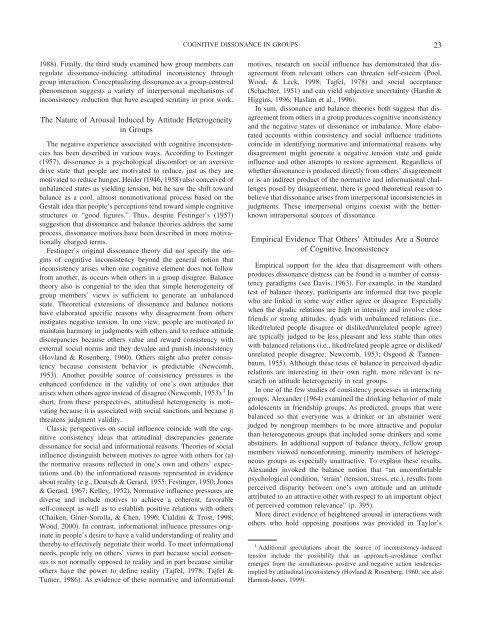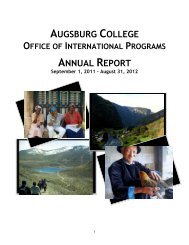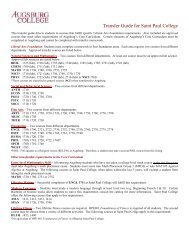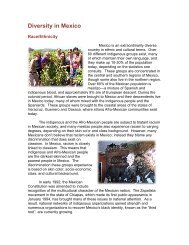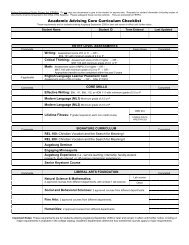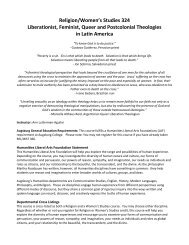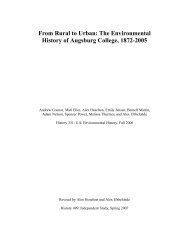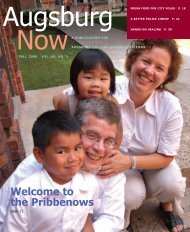Full Text PDF - American Psychological Association
Full Text PDF - American Psychological Association
Full Text PDF - American Psychological Association
- No tags were found...
You also want an ePaper? Increase the reach of your titles
YUMPU automatically turns print PDFs into web optimized ePapers that Google loves.
COGNITIVE DISSONANCE IN GROUPS231988). Finally, the third study examined how group members canregulate dissonance-inducing attitudinal inconsistency throughgroup interaction. Conceptualizing dissonance as a group-centeredphenomenon suggests a variety of interpersonal mechanisms ofinconsistency reduction that have escaped scrutiny in prior work.The Nature of Arousal Induced by Attitude Heterogeneityin GroupsThe negative experience associated with cognitive inconsistencieshas been described in various ways. According to Festinger(1957), dissonance is a psychological discomfort or an aversivedrive state that people are motivated to reduce, just as they aremotivated to reduce hunger. Heider (1946, 1958) also conceived ofunbalanced states as yielding tension, but he saw the shift towardbalance as a cool, almost nonmotivational process based on theGestalt idea that people’s perceptions tend toward simple cognitivestructures or “good figures.” Thus, despite Festinger’s (1957)suggestion that dissonance and balance theories address the sameprocess, dissonance motives have been described in more motivationallycharged terms.Festinger’s original dissonance theory did not specify the originsof cognitive inconsistency beyond the general notion thatinconsistency arises when one cognitive element does not followfrom another, as occurs when others in a group disagree. Balancetheory also is congenial to the idea that simple heterogeneity ofgroup members’ views is sufficient to generate an unbalancedstate. Theoretical extensions of dissonance and balance notionshave elaborated specific reasons why disagreement from othersinstigates negative tension. In one view, people are motivated tomaintain harmony in judgments with others and to reduce attitudediscrepancies because others value and reward consistency withexternal social norms and they devalue and punish inconsistency(Hovland & Rosenberg, 1960). Others might also prefer consistencybecause consistent behavior is predictable (Newcomb,1953). Another possible source of consistency pressures is theenhanced confidence in the validity of one’s own attitudes thatarises when others agree instead of disagree (Newcomb, 1953). 1 Inshort, from these perspectives, attitudinal heterogeneity is motivatingbecause it is associated with social sanctions and because itthreatens judgment validity.Classic perspectives on social influence coincide with the cognitiveconsistency ideas that attitudinal discrepancies generatedissonance for social and informational reasons. Theories of socialinfluence distinguish between motives to agree with others for (a)the normative reasons reflected in one’s own and others’ expectationsand (b) the informational reasons represented in evidenceabout reality (e.g., Deutsch & Gerard, 1955; Festinger, 1950; Jones& Gerard, 1967; Kelley, 1952). Normative influence pressures arediverse and include motives to achieve a coherent, favorableself-concept as well as to establish positive relations with others(Chaiken, Giner-Sorolla, & Chen, 1996; Cialdini & Trost, 1998;Wood, 2000). In contrast, informational influence pressures originatein people’s desire to have a valid understanding of reality andthereby to effectively negotiate their world. To meet informationalneeds, people rely on others’ views in part because social consensusis not normally opposed to reality and in part because similarothers have the power to define reality (Tajfel, 1978; Tajfel &Turner, 1986). As evidence of these normative and informationalmotives, research on social influence has demonstrated that disagreementfrom relevant others can threaten self-esteem (Pool,Wood, & Leck, 1998; Tajfel, 1978) and social acceptance(Schachter, 1951) and can yield subjective uncertainty (Hardin &Higgins, 1996; Haslam et al., 1996).In sum, dissonance and balance theories both suggest that disagreementfrom others in a group produces cognitive inconsistencyand the negative states of dissonance or imbalance. More elaboratedaccounts within consistency and social influence traditionscoincide in identifying normative and informational reasons whydisagreement might generate a negative tension state and guideinfluence and other attempts to restore agreement. Regardless ofwhether dissonance is produced directly from others’ disagreementor is an indirect product of the normative and informational challengesposed by disagreement, there is good theoretical reason tobelieve that dissonance arises from interpersonal inconsistencies injudgments. These interpersonal origins coexist with the betterknownintrapersonal sources of dissonance.Empirical Evidence That Others’ Attitudes Are a Sourceof Cognitive InconsistencyEmpirical support for the idea that disagreement with othersproduces dissonance distress can be found in a number of consistencyparadigms (see Davis, 1963). For example, in the standardtest of balance theory, participants are informed that two peoplewho are linked in some way either agree or disagree. Especiallywhen the dyadic relations are high in intensity and involve closefriends or strong attitudes, dyads with unbalanced relations (i.e.,liked/related people disagree or disliked/unrelated people agree)are typically judged to be less pleasant and less stable than oneswith balanced relations (i.e., liked/related people agree or disliked/unrelated people disagree, Newcomb, 1953; Osgood & Tannenbaum,1955). Although these tests of balance in perceived dyadicrelations are interesting in their own right, more relevant is researchon attitude heterogeneity in real groups.In one of the few studies of consistency processes in interactinggroups, Alexander (1964) examined the drinking behavior of maleadolescents in friendship groups. As predicted, groups that werebalanced so that everyone was a drinker or an abstainer werejudged by nongroup members to be more attractive and popularthan heterogeneous groups that included some drinkers and someabstainers. In additional support of balance theory, fellow groupmembers viewed nonconforming, minority members of heterogeneousgroups as especially unattractive. To explain these results,Alexander invoked the balance notion that “an uncomfortablepsychological condition, ‘strain’ (tension, stress, etc.), results fromperceived disparity between one’s own attitude and an attitudeattributed to an attractive other with respect to an important objectof perceived common relevance” (p. 395).More direct evidence of heightened arousal in interactions withothers who hold opposing positions was provided in Taylor’s1 Additional speculations about the source of inconsistency-inducedtension include the possibility that an approach–avoidance conflictemerges from the simultaneous positive and negative action tendenciesimplied by attitudinal inconsistency (Hovland & Rosenberg, 1960; see alsoHarmon-Jones, 1999).


